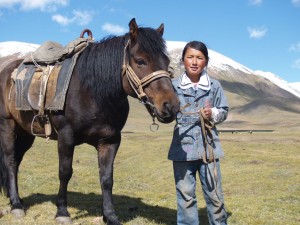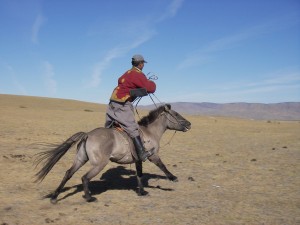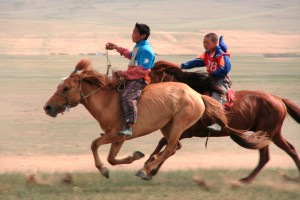A Little About Mongolian Horses
 When I decided to do this project on horseback, I decided that I should probably learn a bit about the horses that I will be dealing with in Mongolia. Though the exact origins of the breed are hard to determine, it is generally thought that Mongolian horses descend from primitive wild horse breeds such as the Takhi (known in the west as Przewalski’s Horse) and others which are now extinct. Horses have been a staple of Mongolian society for virtually as long as it has existed, and horseback riding has been documented with the nomads of the central Asian steppes at least as far back as 2000 BC. The horses are very resistant to cold, and their hair is very fine and frequently used for the bows of the Morin Khuur, or Mongolian Horse-Head Fiddle. Their hooves are also extremely tough and very few are ever fitted with horseshoes.
When I decided to do this project on horseback, I decided that I should probably learn a bit about the horses that I will be dealing with in Mongolia. Though the exact origins of the breed are hard to determine, it is generally thought that Mongolian horses descend from primitive wild horse breeds such as the Takhi (known in the west as Przewalski’s Horse) and others which are now extinct. Horses have been a staple of Mongolian society for virtually as long as it has existed, and horseback riding has been documented with the nomads of the central Asian steppes at least as far back as 2000 BC. The horses are very resistant to cold, and their hair is very fine and frequently used for the bows of the Morin Khuur, or Mongolian Horse-Head Fiddle. Their hooves are also extremely tough and very few are ever fitted with horseshoes.
I am a semi-experienced rider (Western lessons in childhood and English lessons during college), but Mongolians are arguably the most skilled riders on the planet, and I don’t want to look like an idiot when I get there. Once I decided that I would be doing this project on horseback, I started riding my friend Christiane’s horse as often as possible. Kalumet is about as far from the physical stature of a Mongolian horse as I one can get, but any riding experience is better than no riding experience. That said, there’s still going to be a pretty steep learning curve because…
 Mongolian horses are almost impossible for a western rider to prepare for. They are short, stocky, and most have five gaits instead of four (the fifth being a running walk variously called tölt, single-footing, or racking). Mongolian horses are also typically not as “broken” as western horses, and are frequently wilder and more difficult to control. Whereas western equitation focuses on complete control of the horse as the pinnacle of achievement, Mongolian equitation focuses on having a horse that is capable of judging what is best for a given situation while the rider is busy with other tasks. Mongolians put a huge amount of trust into the abilities of their horses, and that changes they way that they ride. The saddle itself provides a very stable seat due to its high back and front, but it only allows minimal control over the horse. More control is given to the horse than in western riding, and I have read countless accounts of westerners trying to ride a Mongolian horse the way they would ride a western horse, and the Mongolian horses essentially rebel against such heavy-handed attempts at subjugation. Mongolian horses are independent and expect to be allowed to think for themselves and judge what is probably best for the situation at hand. Most seem to prefer cantering in virtually any situation. Racing horses will run at full gallop for over 35 km at a time, and they are trained to keep running even after losing their riders, so you have to make sure not to fall off!
Mongolian horses are almost impossible for a western rider to prepare for. They are short, stocky, and most have five gaits instead of four (the fifth being a running walk variously called tölt, single-footing, or racking). Mongolian horses are also typically not as “broken” as western horses, and are frequently wilder and more difficult to control. Whereas western equitation focuses on complete control of the horse as the pinnacle of achievement, Mongolian equitation focuses on having a horse that is capable of judging what is best for a given situation while the rider is busy with other tasks. Mongolians put a huge amount of trust into the abilities of their horses, and that changes they way that they ride. The saddle itself provides a very stable seat due to its high back and front, but it only allows minimal control over the horse. More control is given to the horse than in western riding, and I have read countless accounts of westerners trying to ride a Mongolian horse the way they would ride a western horse, and the Mongolian horses essentially rebel against such heavy-handed attempts at subjugation. Mongolian horses are independent and expect to be allowed to think for themselves and judge what is probably best for the situation at hand. Most seem to prefer cantering in virtually any situation. Racing horses will run at full gallop for over 35 km at a time, and they are trained to keep running even after losing their riders, so you have to make sure not to fall off!
 Though Mongolians do not typically name their horses as westerners do, they do frequently have favourites, and in groups each family member will have his or her own horse. These horses are generally valued more highly than other working horses, and are given somewhat preferential treatment. That said, horses are primarily a working animal in Mongolia, and they are not pampered as they are in the west. As a friend of mine says, “Mongolians see horses the way most people see their cars.”
Though Mongolians do not typically name their horses as westerners do, they do frequently have favourites, and in groups each family member will have his or her own horse. These horses are generally valued more highly than other working horses, and are given somewhat preferential treatment. That said, horses are primarily a working animal in Mongolia, and they are not pampered as they are in the west. As a friend of mine says, “Mongolians see horses the way most people see their cars.”
Being a short, somewhat stocky person much like your average Mongolian, I am really looking forward to finally being able to ride horses that are smaller than what you can get in the west. I also eagerly anticipate finally being able to ride for as long as I want without worrying about running into a fence. With Mongolia’s lack of territorial fences, it’s not hard to see how they are able to maintain such a strong, horse-based culture. They have no boundaries.
[Photos by Kate MacLeod, Emilia Tjernström, Lee LeFever]
















More unsolicited advice (hope you don’t mind):
Where do you plan to get your horses? While there are horses all over Mongolia, you may have a hard time negotiating and/or explaining what kind of horses you want/need unless you get pretty good at Mongolian before going. Also, it’s not always easy for Mongolians to part with their calmest horses (which will probably be the ones you want to ride around on, since falling off your horse and injuring yourself in the middle of the steppe will make your project much less pleasant), unless they have many.
A good way to describe a good horse (apart from just the term “Nomkhon mör” which means calm horse) is that you should be able to ride it while eating pine nuts (during pine nut season, you can buy huge bags of pine nuts, and you ride along cracking open the pine nut shells with your teeth and eating — it does a pretty good job of describing the kind of horse that you might want for your journey.
You might consider finding a Mongolian who’d be willing to ride around a bit with you before you set off on your own: you don’t just need to know how to ride a Mongolian horse, but you also need to practice saddling (pretty different from saddling Western or European), tying up the horses over night, packing the second horse (I assume you’ll keep your gear on the second horse), how to avoid having your horses stolen during the night while you sleep (particularly around Hovsgol this is a pretty big issue), how to recognize if the horses are doing ok and when they need rest (this might be more often than you think)…
Another thing that one might not think about is this: if you plan to sell your horses at the end of your trip, you want to make sure you rest them often. If they’re too skinny, they will be hard to sell if winter is drawing near (summer is short; I’ve gotten caught in a snow storm in early September). Come to think of it, this holds even if you don’t want to sell your horses, but if you simply want them to survive the winter. Even if the coming winter does not bring a dzud, horses that go into fall skinny will have a much harder time making it.
Just a few tidbits from a girl who’s ridden around with two horses in Mongolia before ;)
If I go the purchasing route rather than the renting route, I am planning on getting my horses at the big market in UB, where I have access to my guide friend who will be doing all the negotiating for me. He’s quite experienced at horse purchasing, so I trust in his ability to get me a good horse.
Thanks for the tidbit about how to describe a calm horse – that kind of info is always useful (my friend in UB recently told me how to describe a horse with a soft gait, too).
I’ll be emailing you sometime in the next day or two to pick your brain a bit more.
I’ve been to Mongolia five times and have just found your blog via a Mongol Facebook friend.
Great post!
One factual correction. The domestic Mongol horse is not descended from the takhi. My research (painting them is one of my specialties as an artist) indicates that they diverged into two lines around 500,000 years ago. They have different chromosome counts, but can still breed and produce fertile offspring, so the process of specieation is not yet complete.
If you are interested, I blog about Mongolia every Monday at http://www.foxstudio.wordpress.com.
“Mongolian equitation focuses on having a horse that is capable of judging what is best for a given situation while the rider is busy with other tasks.”
You have just described a cutting and roping horse, particular one on a working ranch. If you’re in the US right now, find a Western (as in, American western) stock horse or sport horse trainer and take lessons on their school horses.
To know what it’s like to ride a Mongolian horse: see if you can find a Norwegian Fjord to ride. Fjords are one of the oldest breeds in the world, very closely related to their cousins in Asia. They are the same height and have almost the same confirmation as Mongolian horses.